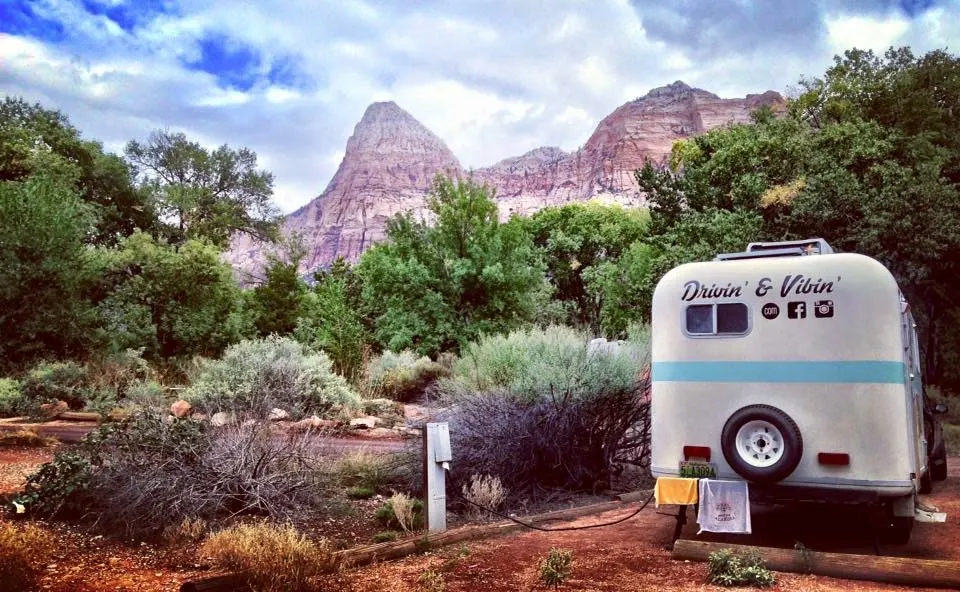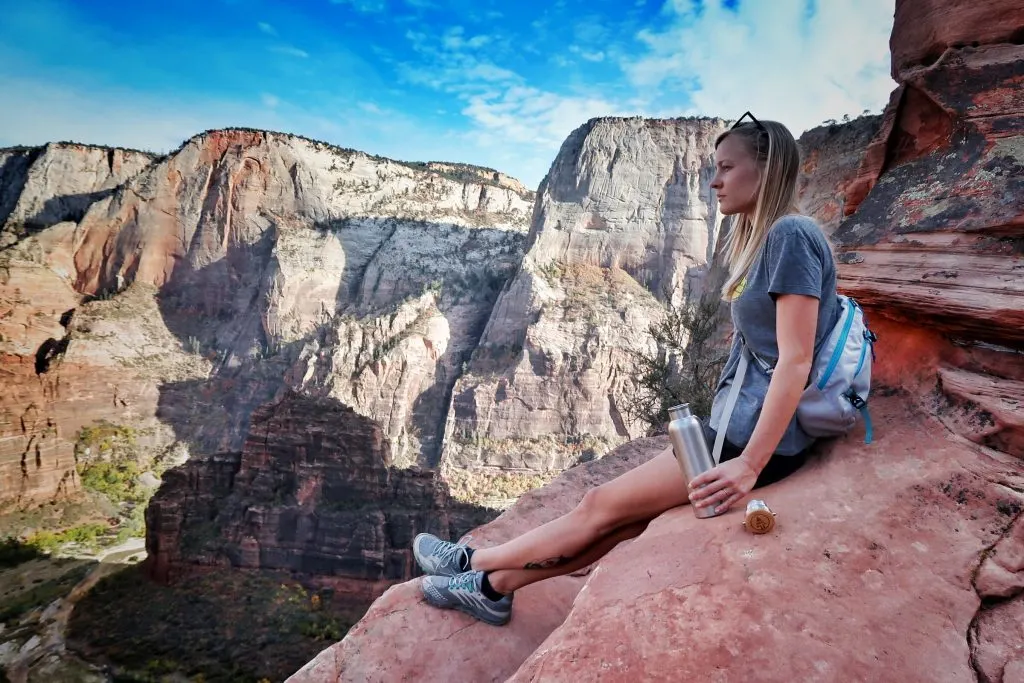The sweet joys of camping at Zion National Park.
Imagine towering red cliffs kissing the sky, narrow canyons beckoning you to explore their depths, and the whisper of the Virgin River guiding you through a desert oasis. Zion National Park isn’t just a destination; it’s an experience that redefines awe.
But before you hitch up your RV and set course for this natural wonder, there are some unwritten rules you ought to know.
After a few trips filled with surprises we didn’t sign up for, we’ve gathered the secret rules of Zion National Park camping that no one else will tell you. Buckle up—your epic adventure starts here.

1. Stay Inside the Park, Not Outside
Trust us, basing yourself inside Zion National Park beats lodging outside its boundaries any day of the week. The convenience of waking up surrounded by colossal sandstone cliffs is priceless. South Campground and Watchman Campground are your main options within the park. We once thought we were clever by staying outside to save a few bucks, only to spend more time and gas dealing with the congested park entrance than enjoying the scenery.
By staying inside, you have immediate access to the park’s shuttle system—a lifesaver since private vehicles aren’t allowed on the Zion Canyon Scenic Drive during peak season. Plus, you’re perfectly positioned to catch the first light hitting the canyon walls without needing to drive anywhere. The campsites are well-maintained, and the amenities exceed typical national park standards.
Pro Tip: Reservations open up months in advance and fill up faster than a flash flood in a slot canyon. If you miss out, aim to arrive early for first-come, first-served sites, but be prepared for a bit of competition.

2. Arrive With Groceries
Zion’s breathtaking vistas won’t feed you, and local grocery options leave much to be desired—unless you’re into overpriced basics and limited selection. We learned this the hard way when we paid a small fortune for a carton of eggs that were past their prime.
Do yourself a favor and stock up on groceries before you get anywhere near the park. Towns like St. George or even Las Vegas offer a wider variety and more reasonable prices. This is crucial if you have specific dietary needs or just prefer not to be at the mercy of the local gas station’s snack aisle.
Cooking at your campsite not only saves money but also spares you from the limited dining options nearby.
Pro Tip: Don’t forget the essentials like drinking water, firewood, and your favorite coffee blend. The camp stores inside the park carry basic supplies but at a premium. And trust us, instant coffee just doesn’t cut it when you’re trying to savor a sunrise over the canyon. (We recommend a french press for camping)

3. Remember Nearby Free Camping
If the campgrounds inside Zion are full or you’re looking to keep your expenses low, consider the free camping options in the surrounding BLM (Bureau of Land Management) areas. We stumbled upon these spots after failing to secure a reservation and found ourselves camping under a canopy of stars, miles away from the nearest RV generator hum.
These dispersed camping areas offer zero amenities—no water, no toilets, no picnic tables. You’ll need to be fully self-sufficient, which adds a rugged charm to your adventure. The solitude and unspoiled natural beauty make it a fantastic option for those willing to rough it a bit.
Pro Tip: Always check the latest BLM regulations before setting up camp. Fire restrictions are common, and some areas may require permits. A reliable map and possibly a vehicle with decent ground clearance will make your life easier.

4. Hike Angels Landing, But Be Prepared
Angels Landing isn’t just a hike; it’s an exercise in conquering your fears and testing your endurance. The trail is famous for its narrow ridges and steep drop-offs, with chains bolted into the rock to help you navigate the most precarious sections. We’ve seen people start this hike full of bravado and turn back halfway when reality sets in.
Begin your trek early to avoid the crowds and the midday desert heat. Bring more water than you think you’ll need, and pack some snacks to keep your energy up. And please, wear proper hiking shoes. This isn’t the place for flip-flops or worn-out sneakers.
Pro Tip: Weather can make or break your hike. High winds or rain can turn this trail into a real hazard. If conditions aren’t ideal, consider alternative hikes like Observation Point, which offers equally stunning views with a bit more terra firma underfoot.

5. Live Luxurious, Stay at the Lodge
Camping is all well and good, but sometimes a little luxury can elevate your park experience. The Zion Lodge provides comfortable rooms right in the heart of the canyon. We treated ourselves to a night here after a particularly grueling hike and found that a real bed and a hot shower can feel like the height of opulence.
Staying at the lodge allows you to soak in the park’s beauty with minimal effort. Wake up, step outside, and you’re already where you want to be. The on-site dining options are a welcome break from campfire cooking, offering meals that feel downright gourmet after days of trail mix and canned chili.
Pro Tip: Reservations are a must and can be made up to a year in advance. Even if you don’t stay overnight, the lodge’s restaurant is open to all and offers a great dining experience with stellar views.
6. Be Prepared With Routing, Especially If Arriving from the East
The Zion-Mount Carmel Tunnel is both a marvel and a potential roadblock, depending on your vehicle. This historic tunnel has height and width restrictions that can complicate things for RVs and vehicles towing trailers. Oversized vehicles require a permit and can only pass through during designated times when traffic is one-way.
We once ignored these details and found ourselves in a tight squeeze—literally. Navigating the tunnel with an RV that’s pushing the size limits is not for the faint of heart. Save yourself the stress and plan your route carefully.
Pro Tip: If your vehicle exceeds the tunnel’s restrictions, consider taking the alternative route via Highway 59 and Highway 389. It’s longer but offers peace of mind and some pretty incredible scenery along the way.

7. Reserve Quickly, or Risk First Come First Served
Zion’s campgrounds are in high demand, and spots disappear faster than ice cubes in the desert. If you don’t secure a reservation well in advance, you may find yourself relying on the unpredictable first-come, first-served system.
We once thought we’d chance it and arrived at dawn, only to join a line of hopeful campers with the same idea. After hours of waiting and no guarantee of a site, we ended up camping outside the park—a less than ideal scenario.
Pro Tip: Mark your calendar for when reservations open and set an alarm if you have to. If you miss out, have a backup plan that includes alternative campgrounds or dispersed camping options.

How to Spend the Perfect Three Days at Zion National Park
Maximizing your Zion experience over a long weekend? Here’s how we’d do it:
Day 1: Settle In and Explore the Easy Trails
- Morning: Check into your reserved spot at Watchman Campground. Take some time to set up and familiarize yourself with the surroundings.
- Afternoon: Take the shuttle to the Emerald Pools Trail. It’s a moderate hike with waterfalls and beautiful vistas—perfect for warming up.
- Evening: Enjoy a leisurely dinner at your campsite or splurge at the lodge’s restaurant. Watch the stars come out; the night sky here is something else.
Day 2: Tackle the Big Adventures
- Early Morning: Embark on the Angels Landing hike. Beat the crowds and the heat by starting at sunrise.
- Afternoon: After conquering Angels Landing, relax by the Virgin River or take a scenic drive to the east side of the park.
- Evening: Attend a ranger-led program to deepen your appreciation for this incredible place.
Day 3: Experience The Narrows
- Morning: Hike The Narrows, starting from the Temple of Sinawava. Walking through the river between towering canyon walls is an unforgettable experience.
- Afternoon: Return to camp, pack up, and perhaps take a final stroll along the Pa’rus Trail.
- Evening: Head into Springdale for a farewell meal before hitting the road.

Final Thoughts: Always keep an eye on the weather and be prepared to adjust your plans. Flexibility can turn unexpected changes into memorable adventures.
Camping at Zion is a Tradition We’ll Do Time and Time Again
Zion National Park is a place that captures the imagination and stirs the soul. By keeping these secret rules in mind, you’re setting the stage for a trip that’s memorable for all the right reasons.
So gear up, plan ahead, and get ready to create stories you’ll be telling for years to come.
We’ll Help You Find the Best Free Camping in the USA
You should give it a try!
As a matter of fact, these free campsites are yours to enjoy. Every time you pay federal taxes, you’re contributing to these lands.
Become a FREE CAMPING INSIDER and join the 100,000 campers who love to score the best site!
We’ll send you the 50 Best Free Campsites in the USA (one per state). Access the list by submitting your email below: